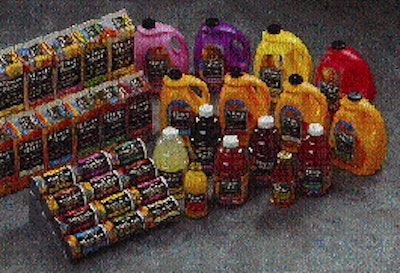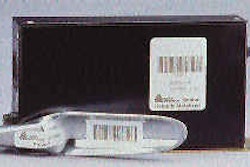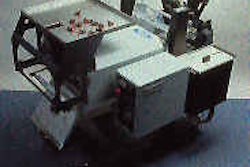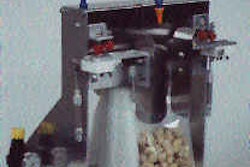As the $12-billion juice and juice drink market continues to grow steadily, it's little wonder that the marketing masterminds behind the category are doing everything they can to maximize market share. Innovative packaging is proving to be one of their most relied-upon strategies. Chiquita Brands and Coca-Cola Foods offer glimpses of how such innovation bears fruit. Cincinnati-based Chiquita turned to new packaging technology in launching a 48-oz gabletop carton. The firm is using the new slim carton to introduce Chiquita Light, which has 35 calories per 8-oz serving compared to 110 in 8 oz of orange juice. Three of Chiquita's 100% juice blends are also offered in the 48-oz carton. Contract packager Home Juice, Melrose Park, IL, packages the juices on a system from Tetra Pak (Chicago, IL). The carton is described by Tetra as the "first U.S.A. gabletop carton innovation in over 30 years." Measuring 95 mm across and 70 mm deep (3.74" x 2.75"), it has the same face as the traditional half gallon carton that measures 95 x 95 mm (3.74" x 3.74"). But it handles more like a quart. "For consumers," says Chiquita brand manager Karen Lucas, "it's easier to store and pour. Also, because there's less in it than the half-gallon container, it's consumed more quickly, so there's less chance for product degradation. You get a better, fresher tasting product. "For retailers, there are two major advantages: the smaller carton footprint means more on-shelf product, while its new technology and our new packing process mean an extended shelf life-now 90 days." Shelf life on Chiquita's half-gallon gabletop cartons is typically 50 to 55 days. The 90-day shelf life on the new 48-oz carton is achieved thanks to extended-shelf-life (ESL) machinery and a sophisticated barrier layer in the carton. The machinery is Tetra's TR6/ESL Slim, the first in the world. Like the TR6/ESL that's been churning out half-gallon cartons for the past two years, the machine sprays a hydrogen peroxide solution inside the carton and dries it out just before the filling station. This extra sterilization step kills bacteria that, if left alive, shorten the product's shelf life. According to Tetra's Mike Berg, the additional processing step in itself does not cause the ESL machine to be slower than a TR6 without the ESL option. But the rectangular shape of the 48-oz carton leads to a bit more sloshing than is experienced with the squared-off half gallon, and that does require some reduction in speed. The Chiquita cartons are filled at a rate of 65/min. Rare use of SiOx coating Even more intriguing than the equipment is the material, which includes a coating of silicon oxide (SiOx) for barrier purposes. SiOx, as most will recall, burst on the scene a few years ago and was touted as a "glass coating" that would give flexible film structures barrier properties comparable to foil yet offer product visibility as well. But outside of Japan, few firms have commercialized this "breakthrough" material. Some are worried about its novelty, others its cost. Still, its promise and potential has kept it in the minds, if not on the spec sheets, of many in the food and beverage business. So Chiquita's test will be watched closely. SiOx-coated board has been available from Tetra Pak since October. It entered the Tetra Pak picture through a joint development contract with Airco Coating Technology (Fairfield, CA). "Silicon oxide is an alternative to foil," says Berg. "In tests we've done, it has better barrier properties than EVOH [ethylene-vinyl alcohol] and in some cases even better than foil, where pinholes can enter the picture." So will Tetra cease offering gabletop carton blanks that use foil for their barrier? "We'll let the market decide that," says Berg. "I see no reason to phase out foil if people want it. But I expect to see considerable interest in the silicon oxide alternative." Tetra and Chiquita worked closely together to bring SiOx-coated gabletop cartons from the laboratory to the marketplace. Chiquita's technical people were impressed by the barrier performances of the new material compared to that of foil, so they decided to try it. When asked for specific details about the decision or the carton, however, they were reluctant to elaborate. "Suffice it to say we're excited about this package or we wouldn't have gone as far as we have with it," says Jim Perz, director of technical services and quality assurance at Chiquita. For now, Tetra does its SiOx coating in one of its Swiss development facilities. The coating, called QLF® coating by Airco, is deposited by means of chemical plasma deposition. In the case of the Chiquita carton, the Swiss firm coats a PE film with SiOx and sends the coated material as rollstock to Tetra's Denton, TX, converting plant. There it's adhesive-laminated to a PE/paper/PE structure. Then the finished lamination is sent to Tetra's Vancouver, WA, plant for offset-printing in five colors and die-cutting into carton blanks. The cost of SiOx-coated cartons is tough to pin down at this point. Chiquita's Perz declines to comment. Says Tetra's Berg: "We're not 100% set yet on our costing. Volumes aren't up yet to where we can get the economies of scale we'll eventually get. But our intention is to offer silicon oxide-coated packaging material at a price that's competitive with a foil-containing board." Chiquita's 48-oz gabletop cartons are currently available in four test cities: Louisville, KY; Albany, NY; Cincinnati, OH; and St. Louis, MO. They sell for a suggested retail price between $1.79 and $2.29. "We see a huge opportunity in this package," says Chiquita's Lucas. Redesign means end of an era While Chiquita's changes are structural in nature, Coca-Cola Foods of Houston, TX, has been busy redesigning the appearance of its packages. The most dramatic change is in its Minute Maid brand, where the well-known black package, introduced in the mid '60s but now viewed by Coca-Cola Foods as outdated, has been replaced. The new Minute Maid packaging features what Coca-Cola Foods calls a "first-time-ever 360-degree panel of bright, fresh-fruit photography accented by a traditional woodcut and logo on a black background." "No one has ever achieved this before," says Don Knauss, senior vice president of marketing for Coca-Cola foods. "The total package presentation, with its colorful montage of fruit photographs, represents a design breakthrough for Coca-Cola Foods and the juice industry." Among the challenges for package design firm Duffy Design (Minneapolis, MN)-the same firm that executed Coke's Fruitopia package-was to incorporate the new look across many package types. That includes gabletop cartons and plastic jugs of chilled juice sold in the supermarket refrigerated case, composite cans sold in the freezer, plastic and glass containers sold among the shelf-stable offerings, and aseptic drink boxes aimed at kids and their parents. Chilled orange juice in the new package was shipped to retailers early last month. Other Minute Maid packages are rolling out now. "We talked to over 1군 consumers to see what Minute Maid means to them," says Coca-Cola Foods marketing director Craig Binkley. "What we came up with is a unique combination of the traditional Minute Maid look and a graphic representation of all the refreshment, nutrition and goodness that consumers look for when they buy juices or juice drinks." Big changes at Hi-C, too Elsewhere in the Coca-Cola Foods empire, those who manage the Hi-C brand have also been busy. In January they introduced radically new graphics across the entire product line. And beginning April 17, the Hi-C brand will begin a nationwide rollout of 7.7-oz aluminum cans. The two developments are keys in a $67 million initiative to "supercharge" the Hi-C brand, says Hi-C market director Kerry Brooks. The largest ad budget in the brand's history will introduce consumers to the new packages. The new graphics, whose development was spearheaded by Interbrand Schechter (New York, NY), are kid-oriented, no surprise for the leading line of children's fruit beverages. A comic strip design with energetic fruit graphics on an electric yellow background replaces traditional fruit photography. The new 7.7-oz can gets the new graphics, too. "Kids go wild for the 7.7-oz can," says Brooks. "We tested a variety of graphics and new package forms. We found the hot new kids' can was extremely popular with the high-end of our target group-10- to 13-year olds who have gone beyond the juice box." The 201 x 413 cans are litho printed in four colors by supplier Reynolds Metals (Richmond, VA). According to Brooks, rather than replace the popular Hi-C drink box, the can will extend the consumption of the brand into more after-school and weekend time periods. Available in five flavors, the cans will be sold in six-packs priced at $2.19.
























